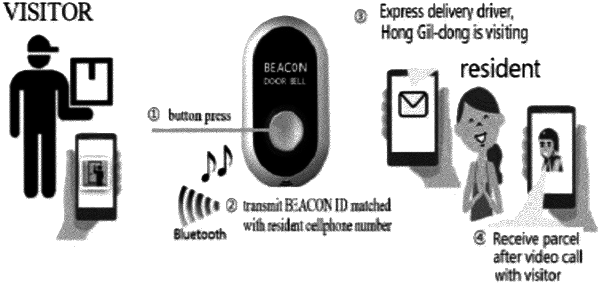| CPC H04W 4/021 (2013.01) [H04W 4/20 (2013.01); H04W 4/80 (2018.02)] | 9 Claims |

|
1. A visitor identification system, comprising:
a wireless doorbell; a visitor application; a management server, a communication resource provided in the visitor application,
wherein the wireless doorbell is installed by a resident and transmits a near field wireless signal,
wherein the wireless doorbell further generates a sound wave upon first manipulation of a visitor,
wherein the visitor application receives the sound wave from the wireless doorbell, determines whether the sound wave received is a predetermined sound wave, and detects whether the communication resource is in an active state or in an inactive state,
wherein the visitor application switches the communication resource to the active state when it is found that (i) the sound wave received is the predetermined sound wave, and (ii) the communication resource is in the inactive state so that the visitor application receives the near field wireless signal from the wireless doorbell,
wherein the visitor application maintains the communication resource in the active state when it is found that (i) the sound wave received is the predetermined sound wave, and (ii) the communication resource is in the active state so that the visitor application receives the near field wireless signal from the wireless doorbell,
wherein the visitor application receives the near field wireless signal from the wireless doorbell, extracts a first identifier from the wireless doorbell, and transmits the first identifier to the management server, wherein the first identifier is unique to the wireless doorbell,
wherein the management server receives the first identifier from the visitor application and performs one or more predetermined tasks so that the resident can verify identity of the visitor.
|